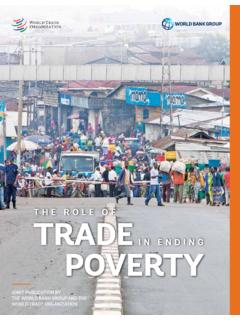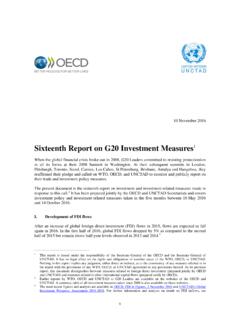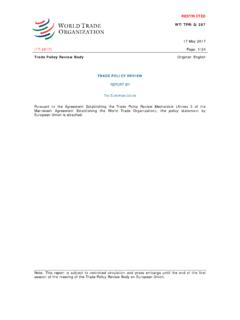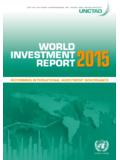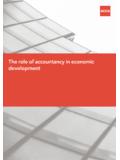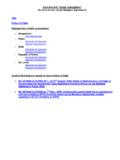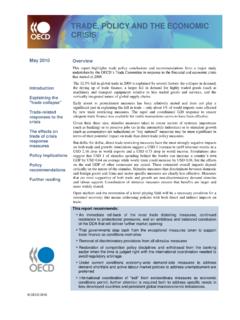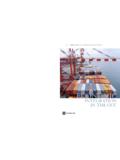Transcription of World Tariff Profiles 2013 - World Trade …
1 10<1520<15<208<106<84<62<40<2 World Tariff Profiles 2015 World Tariff Profiles 2015 WTO ITC UNCTADA pplied MFN tariffsAbout this publicationWorld Tariff Profiles is a co-publication of the WTO, ITC and unctad covering market access for goods. This annual publication contains a comprehensive compilation of the tariffs imposed by each of the 161 WTO members plus a number of other countries and customs territories. Non-WTO members are included in this year s issue if data on the tariffs they applied in 2013 or 2014 are available in the databases of the WTO, ITC or unctad . For more informationThe statistical tables included in this report can be downloaded from the WTO web site at map on the cover represents the latest available average MFN tariffs applied by countries/customs territories.
2 These tariffs (in %) are grouped into eight categories. Data are sourced from this publication (covering 2013 and 2014) and from previous publications if more recent data are not available. The boundaries shown on the map do not imply any judgment, official endorsement or acceptance by the WTO as to the legal status or frontier of any to find more online: the ITC UNCTADW orld Tariff Profiles 2015 ContentsIntroduction2 WTO members and observers 3 General note and abbreviations tables5 Technical notes5 All products 6 Agricultural products 12 Non-agricultural products 1824II. Tariff tables Index of Tariff tables24 Technical notes 25 Tariff tables topic and Technical annexes179 Tariff accumulation, effective protection and export competitiveness in global production 179 Technical annexes sources200C.
3 Frequently asked questions205 Acknowledgements208I SUMMARY TABLESII Tariff TABLESIII SPECIAL TOPIC AND TECHNICAL ANNEXES2 WTO ITC UNCTADW orld Tariff Profiles 2015 Download the World Tariff Profiles is a joint publication of the WTO, ITC and unctad devoted to market access for goods. This statistical yearbook contains a comprehensive compilation of the main Tariff parameters for each of the 161 WTO members plus other countries and customs territories where data is available. Each Tariff profile presents information on tariffs imposed by each economy on its imports complemented with an analysis of the market access conditions it faces in its major export for all countries are given in standardized tables which allow easy comparisons between countries, between sectors and, specifically for WTO members, between bound and applied tariffs as well.
4 The calculations are based on national Tariff schedules and imports in conformity with a standard Harmonized System (HS) nomenclature version. To the extent possible, ad valorem equivalents (AVEs) of non-ad valorem tariffs are estimated and are included in the estimation of Tariff indicators. Nonetheless, certain caveats apply in the interpretation of these indicators and the reader is advised to read the methodological notes that precede the statistical publication is presented in three main parts. The first part shows summary statistics for all countries and territories for all products, as well as a break-down into agricultural and non-agricultural products.
5 The second part shows for each of these countries and territories one full page with disaggregation by sectors and duty ranges. It also contains a section on the market access conditions faced in their respective major export markets. The third part contains the special topic which usually varies with each new edition and the technical annexes. Starting from this edition, summary tables on anti-dumping measures would be a regular part of the technical annexes. The summary tables in the first part are designed to allow cross-country comparison as well as comparison of the levels of bound and applied duties. Apart from the standard indicators like Tariff averages, maxima, percentage of duty-free Tariff lines, peaks and non-ad valorem duties, it also contains indicators of Tariff dispersion such as the number of distinct duties and the coefficient of variation.
6 The calculation of these indicators is based, where applicable, on a pre-aggregation to HS six-digit subheadings, which leads to a standardization across countries and thus makes the comparisons more Tariff tables are divided into two blocks covering (A) the domestic market access protection and (B) the protection faced in the major export markets. In part A, information on bound and applied duties is shown by duty ranges and by sectors. Information for agricultural and non-agricultural duties is shown separately. In addition, there are indicators on the occurrence of special safeguards and on Tariff quotas. In part B, the Trade diversification and market access conditions in the five major export markets are depicted, broken down into agricultural and non-agricultural new special topic is a Tariff -related article entitled Tariff Accumulation, effective protection and export competitiveness in global production.
7 The technical annexes include the tables on anti-dumping measures, data sources and the compilation of Frequently Asked Questions .IntroductionWTOThe World Trade Organization (WTO) is the only global international organization dealing with the rules of Trade between nations. At its heart are the WTO agreements, negotiated and signed by the bulk of the World s trading nations and ratified in their parliaments. The goal is to help producers of goods and services, exporters, and importers conduct their business. The WTO s main function is to ensure that Trade flows as smoothly, predictably and freely as possible. It does this by administering Trade agreements, acting as a forum for Trade negotiations, settling Trade disputes, reviewing national Trade policies, assisting developing countries in Trade policy issues through technical assistance and training programmes and cooperating with other international International Trade Centre (ITC) is the joint agency of the World Trade Organization and the United Nations.
8 ITC enables small business export success in developing countries by providing, with partners, sustainable and inclusive Trade development solutions to the private sector, Trade support institutions and policymakers. ITC s strategic objectives are to strengthen the international competitiveness of enterprises, to develop the capacity of Trade service providers to support businesses, and to support policymakers in integrating the business sector into the global in 1964, the United Nations Conference on Trade and Development ( unctad ) promotes the development-friendly integration of developing countries into the World economy. unctad has progressively evolved into an authoritative knowledge-based institution whose work aims to help shape current policy debates and thinking on development, with a particular focus on ensuring that domestic policies and international action are mutually supportive in bringing about sustainable the ITC UNCTADW orld Tariff Profiles 2015 WTO members and observersWTO membersOthersWTO observersWTO members (as of 15 Aug ust 2015)
9 ObserversAlbania Angola Antigua and Barbuda Argentina Armenia Australia Austria Bahrain, Kingdom of Bangladesh Barbados Belgium Belize Benin Bolivia, Plurinational State ofBotswana Brazil Brunei Darussalam Bulgaria Burkina Faso Burundi Cabo Verde Cambodia Cameroon Canada Central African Republic Chad Chile China Colombia Congo Costa Rica C te d Ivoire Croatia Cuba Cyprus Czech Republic Democratic Republic of the Congo Denmark Djibouti Dominica Dominican Republic Ecuador Egypt El Salvador Estonia European Union (formerly European Communities) Fiji Finland France Gabon The Gambia Georgia Germany Ghana Greece Grenada Guatemala Guinea Guinea-Bissau Guyana Haiti Honduras Hong Kong, China Hungary Iceland India Indonesia Ireland Israel Italy Jamaica Japan Jordan Kenya Korea, Republic ofKuwait, the State ofKyrgyz Republic Lao People s Democratic Republic Latvia Lesotho Liechtenstein Lithuania Luxembourg Macao, China Madagascar Malawi Malaysia Maldives Mali Malta Mauritania Mauritius Mexico Moldova.
10 Republic ofMongolia Montenegro Morocco Mozambique Myanmar Namibia Nepal Netherlands New Zealand Nicaragua Niger Nigeria Norway Oman Pakistan Panama Papua New Guinea Paraguay Peru Philippines Poland Portugal Qatar Romania Russian Federation Rwanda Saint Kitts and Nevis Saint Lucia Saint Vincent & the Grenadines Samoa Saudi Arabia, Kingdom ofSenegal SeychellesSierra Leone Singapore Slovak Republic Slovenia Solomon Islands South AfricaSpain Sri Lanka Suriname Swaziland Sweden Switzerland Chinese Taipei Tajikistan Tanzania Thailand The former Yugoslav Republic of Macedonia (FYROM) Togo Tonga Trinidad and Tobago Tunisia Turkey Uganda Ukraine United Arab Emirates United Kingdom United States of America Uruguay Vanuatu Venezuela, Bolivarian Republic of Viet Nam YemenZambia ZimbabweAfghanistanAlgeriaAndorraAzerbai janBahamasBelarusBhutanBosnia and HerzegovinaComorosEquatorial GuineaEthiopiaHoly See (Vatican) IranIraqKazakhstanLebanese RepublicLiberia, Republic ofLibyaSao Tom and PrincipeSerbiaSudanSyrian Arab RepublicUzbekistan4 WTO ITC UNCTADW orld Tariff Profiles 2015 Download the AverageAG Agricultural productsAVE Ad valorem equivalentHS Harmonized System (nomenclature)
